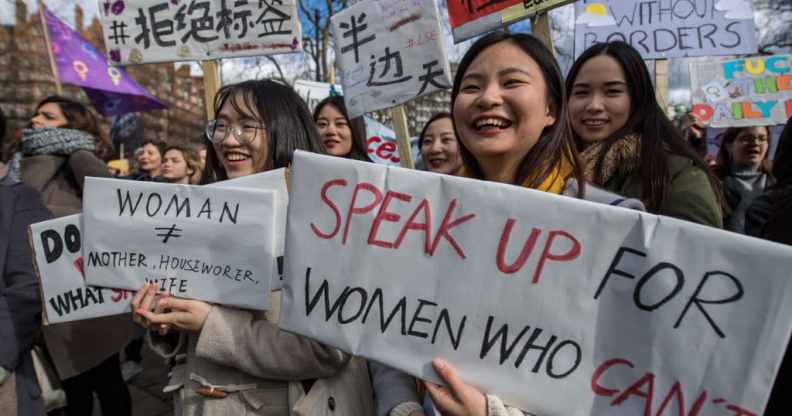International Women’s Day 2021 theme, the history of IWD and why we celebrate

Women’s rights demonstrators hold placards during a rally in Russell Square on International Women’s Day in London. (Getty)
International Women’s Day is celebrated every year on 8 March, and 2021 is no different despite the ongoing pandemic.
It’s intended as a date to mark the many social, economic and political achievements of women across the world.
International Women’s Day is a vital outlet that allows millions of people to stand up for women’s rights, female empowerment and gender equality, as well as honouring trailblazing women throughout history.
International Women’s Day 2021 theme
The official theme for IWD 2021 is “Choose to Challenge”, which is a way to recognise the need to call out gender bias and inequality, something that is needed more than ever as women around the world battle the social, economic and political fallout from Covid-19.
Last year’s theme was #EachforEqual, which recognised the actions we can take as individuals to challenge stereotypes and celebrate women’s achievements. Before that, the International Women’s Day 2019 theme was #BalanceforBetter. The campaign theme aimed for more gender balance in the world.
Why #Choosetochallenge?
The International Women’s Day website reads:
“A challenged world is an alert world. Individually, we’re all responsible for our own thoughts and actions – all day, every day.
“We can all choose to challenge and call out gender bias and inequality. We can all choose to seek out and celebrate women’s achievements. Collectively, we can all help create an inclusive world.
“From challenge comes change, so let’s all choose to challenge.”
What can you do this International Women’s Day?
Firstly, simply become part of the conversation. Join with the hashtag #Choosetochallenge on Twitter and have your say.
Next, you can strike a pose. Use the hashtag #IWD2021 and post it alongside a picture of you on social media.
Raise your hand high to show you’re in and that you commit to choose to challenge and call out inequality.

How can I get involved with International Women’s Day 2021?
You can donate, celebrate, collaborate, volunteer, sponsor and do so many more things.
One thing you can do is watch the purposeful IWD videos as discussion starters, or broadcast them at IWD events to educate, motivate, challenge, and inspire audiences. You can also develop and submit your own #ChooseToChallenge videos for potential inclusion.
Other direct action you can take is to fundraise for a female-focused charity. Despite the pandemic in 2020, IWD still raised a hefty six-figure sum for charity and 100% of the proceeds went directly to charity. IWD provides an important opportunity to fundraise and call for donations to support the ever-important work of gender equality focused charities, so find out more.
Another thing you can do is search the IWD Supplier Directory to source and support women-owned local businesses – from photographers and caterers to PR and more.
International Women’s Day history
The first National Woman’s Day, as it was originally named, was celebrated in the US on February 28, 1909.
The national date was formed to honour women who protested the year before. The protest occurred in New York City in 1908, led by a Ukrainian suffragist named Clara Lemlich. 15,000 female garment workers went on strike. They demanded better pay, shorter working hours and improved working conditions.

In 1910, National Woman’s Day became recognised as an international celebration after German women’s rights activist Clara Zetkin made the suggestion at an International Conference of Working Women in Copenhagen, Denmark.
It was first celebrated as an official international day on March 19, 1911. Germany, Switzerland, Austria and Denmark were amid the first countries to mark the day outside of the US. The day was supported by over one million people.
Fast forward in time, in 1975 during its International Women’s Year, the United Nations joined in on the annual celebration. They supported its aims of campaigning for women right’s worldwide and made it part of the organisation’s mission.

In 1996, the UN began adopting an annual theme for International Women’s Day. The first ever theme for International Women’s Day was “Celebrating the past, Planning for the Future.”
Why do we still mark International Women’s Day?
Sadly, not enough has changed for women since the inaugural IWD, with the gender pay gap, violence against women and ongoing inequality in job opportunities and healthcare still burning issues. Last year, the UN reported that almost 90 per cent of people are prejudiced towards women globally.
You can read more about gender equality here.
How did this story make you feel?

